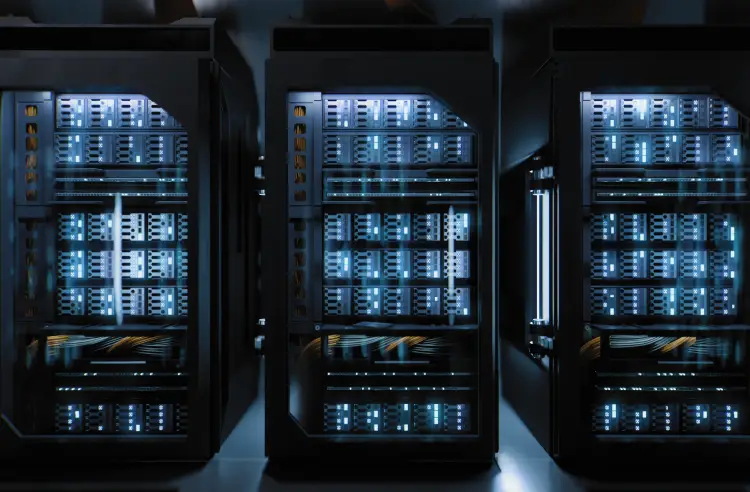
Artificial intelligence has reached the data centre, with automated systems being deployed in server halls around the world to help maintain equipment and ensure the smooth running of services. More automation is likely to follow in the coming years as data centres evolve to cater for the demands of cloud computing and emerging technologies such as 5G and edge networks, but operators are increasingly pessimistic that AI will prove the silver bullet to their ongoing skills shortage.

With demand for data centre space shooting up as a result of widespread digital transformation and many businesses switching to the cloud, improving data centre efficiency will be key to making the most of resources and ensuring the carbon footprint of cloud computing and other digital systems is kept to a minimum. At the same time, the sector faces an acute shortage of skilled workers which threatens to hold back the expansion of centres around the world.
AI could have a role to play in tackling both issues, and Gartner expects that, by 2025, half of cloud data centres will deploy advanced robots with AI and machine learning (ML) capabilities, resulting in what it says will be 30% higher operating efficiency.
“The gap between growing server and storage volumes at data centres, and the number of capable workers to manage them all is expanding,” said Sid Nag, research vice president at Gartner. “The risk of doing nothing to address these shortcomings is significant for companies. Data centre operations will only increase in complexity as organisations move more diverse workloads to the cloud, and as the cloud becomes the platform for a combinatorial use of additional technologies such as edge and 5G, to name a few.”
How is AI deployed in data centres?
AI is commonly found within software that runs in data centres, but automated systems are now also playing a bigger role in maintaining the centres themselves. “We’re starting to see a growth of automation in terms of resolving problems with the IT infrastructure,” says Paul Bevan, research director for IT infrastructure at Bloor. “An example would be if your performance management system shows a problem with a storage device because database back-ups haven’t been carried out properly and the cache needs clearing. That’s a fairly simple task that can and is being automated.”
But Bevan says this increased automation is not found in other areas of data centre management. “When you go back into the areas that are controlled by data centre infrastructure management (DCIM) or building management systems, the level of automation is much lower,” he says.
The nearer you are to the application, the more automation there is and the faster it is moving. The rest has got some catching up to do.
Paul Bevan, Bloor
This is partly because many older data centres have mechanical equipment which doesn’t have the interfaces required to connect it to modern AI systems, Bevan says. He adds that there is also “a reticence among some operational managers at that level and a certain scepticism around AI, which means the automation of physical buildings is taking a little longer.” This is because a failure of the technology could lead to costly outages.
“There’s a lot of work going on at companies like Schneider Electric around the automation of heating and power, but actual uptake has been fairly slow,” Bevan continues. “Some of that is to do with investment cycles because this isn’t cheap stuff. But generally speaking, the nearer you are to the application the more automation there is and the faster it is moving. The rest has got some catching up to do.”
Could more AI help improve data centres?
Despite the reservations of staff, DCIM systems are likely to be the next frontier for AI in the data centre, due largely to the drive to reduce carbon emissions. “Data centres are energy-intensive facilities responsible for about 1% of electricity consumption worldwide,” says Dr Moises Levy, principal analyst, data centre physical infrastructure, at Omdia.
Tech Monitor has previously reported on the sizeable carbon footprint of cloud computing data centres, which the public cloud providers seek to mitigate by using more renewable energy or buying renewables to offset their own emissions. Dr Levy says AI could be used to help reduce power consumption by making servers operate more efficiently. “Data centre energy consumption is all about workloads,” he says. “Servers consume energy and dissipate heat, both of which vary depending on the workload being processed. The thermal management system cools down the facility by extracting the heat. Thermal behaviour is therefore affected by the workloads processed.”
AI can help understand, measure, and predict workloads in real time, and therefore allocate resources accordingly, Dr Levy says. “To be more energy efficient we can shift workloads processing across time and even across locations based on resources,” he adds. “We are living an era where AI-enabled tools can help automate workload management, learning information directly from data without predetermined equations.”
Google has already made significant advances in this respect through its Deepmind AI division, which has used its algorithms to analyse historical data and help reduce the electricity consumption at the company’s data centres by 40%.
Other companies are starting to catch up says Stefanie Williams, senior research analyst at 451 Research, and significant investments are starting to be made in this area. “The idea is that the DCIM will move from simply monitoring the equipment and analysing usage into actually controlling the infrastructure in order to efficiently cool facilities based on those analytics,” she says. “This would include making adjustments to various pieces of equipment to reduce wear-and-tear and prolong the life of the machines and increase the efficiency of cooling by addressing hot-spots more effectively and reducing the risk of human error within facilities.” The same principles could apply with AI-driven power distribution and space planning, Williams adds.
Can AI solve the data centre staffing crisis?
As demands on data centres grow, staffing requirements are also on the up. Research from the Uptime Institute estimates that the number of full-time staff required in data centres around the world will grow from 2 million in 2019 to 2.3 million by 2025. But a separate Uptime Institute survey of data centre operators found that 47% are struggling to attract talent to fill open roles, with 32% of respondents stating they have difficulty retaining existing talent. A fifth (20%) attribute this to workers being poached by rivals, while 12% say staff have left for other industries.
"Staffing is one of the biggest problems," says Ed Galvin, CEO of DC Byte, a research and analytics company covering the data centre market. "The industry is booming, but there is no clear career path for someone at university who wants to get into the sector. So they might go down the computer science route or the engineering route, but no one really knows there's this huge area of infrastructure which presents a big opportunity."
A lot of people from that first wave of data centres 20-25 years ago are getting close to retirement age, which is presenting a real problem.
Ed Galvin, DC Byte
This lack of routes into the industry has caused another problem: an ageing workforce. "Companies have cannibalised staff off each other," Galvin says. "So everyone is getting more senior, to the point where a lot of people from that first wave of data centres 20-25 years ago are getting close to retirement age, which is presenting a real problem."
Is AI the answer? Data centre operators are sceptical that it will come to their rescue in the short term, with 50% of respondents to the Uptime Institute poll saying they don't expect AI to reduce staffing levels for at least the next five years, up from 42% when the same question was asked in 2019.
Galvin believes this reflects the fact that removing humans from the loop is not easy given the expertise of those who work in the industry. "Data centres are not typically that people-heavy," he says. "A big 30-megawatt data centre might have a team of ten to 15 people running it, but they're all very skilled. So a certain amount of automation might help because there are applications that can be aggregated and outsourced to machines, but the reality is there's only so much you can do [without a human] and that's why those who do work in the industry are able to command high salaries."
In the longer term, robotics may provide an answer. Earlier this year, data centre provider NTT demonstrated a robot it has developed that can carry out maintenance tasks on data centre servers.
Galvin says the trend towards smaller, more distributed data centres – known as 'dark sites' – catering for applications such as edge devices and 5G networks, will intensify the need for automation. "You simply can't man them economically," he says. "So they're either going to be remotely operated or self-operated. With these dark sites you're starting to see 'roaming robots' which patrol centres with infrared cameras and, with a bit of machine learning, are able to spot and flag hotspots which are usually the first sign of a short circuit in a piece of equipment. That can then be passed on to a human operator who can review it manually."
For now, Bloor Research's Bevan believes companies would rather mitigate the effects of the skills shortage in other ways rather than turn to AI, which remains relatively unproven. "We're still fairly early in the cycle of AI and automation in this area," he says. "A lot of people are still looking at it and saying 'I'm not going first. I want to see what the risks are and how those risks can be mitigated'."
But, he says, CIOs and other tech leaders need to be aware of the changing face of data centres. "The whole automation piece [in data centres] is getting really hot," he says. "There's still a danger of hype creeping in, but when you consider the pressures of growth and the changes that have happened in the real-time digital economy since Covid-19, you need to be studying these issues around automation and AI, and how they might apply to your business, now. If not you risk getting left behind."






